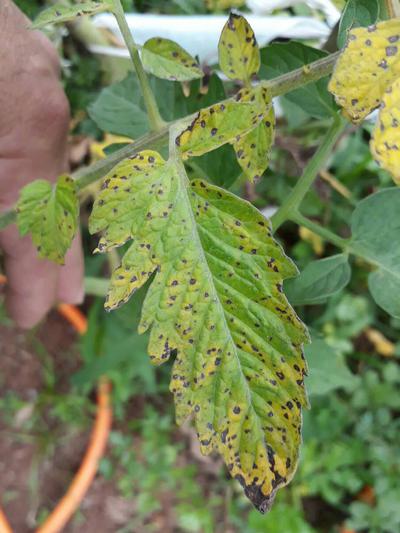Bacterial Spot and Speck of Tomato
Xanthomonas spp. & Pseudomonas syringae pv. tomato
Bacteria
In a Nutshell
- Small dark spots with a yellow halo on leaves and fruits.
- Stem and flower stalk also affected.
Can also be found in
Symptoms
Symptoms can be seen on the foliage, stems, and fruits of tomatoes. Initially small yellow-green lesions appear on young leaves for bacterial spot, whilst bacterial speck causes black spots with a narrow yellow halo. They are usually more numerous on leaf margins or tips, which may appear deformed and twisted. In severe cases, the spots of bacterial speck may coalesce or overlap, resulting in larger and irregular lesions. Bacterial spot lesions can enlarge from 0.25 cm to 0.5 cm and become tan to brownish-red, which will eventually look like shot holes when the center dries up. Bacterial spot produces similar lesion of fruits as it does on the leaves and eventually roughen, becoming brown and scabbed. Bacterial speck causes tiny, slightly raised black specks. It is difficult to distinguish between these two diseases at an early stage.
Recommendations

Organic Control
Bacterial Spot is very difficult to control and also expensive to treat. If the disease occurs early in the season, consider destroying the entire crop. Copper-containing bactericides provide a protective cover on foliage and fruit for both bacteria. Bacterial viruses (bacteriophages) that specifically kill the bacteria are available for the bacterial spot. Submerging seeds for one minute in sodium hypochlorite or in hot water (50°C) for 25 minutes can reduce the incidence of both diseases.

Chemical Control
Always consider an integrated approach with preventive measures together with biological treatments, if available. Copper-containing bactericides can be used as a protectant and give partial disease control. Application at first sign of disease and then at 10 to 14-day intervals when warm (spot) / cold (speck), moist conditions prevail. As the development of resistance to copper is frequent, a combination of copper-based bactericide with mancozeb is also recommended.
What caused it?
Bacterial Spot and Speck are caused by several species of bacteria of the genus Xanthomonas, and Pseudomonas syringae pv. tomato. Bacterial spot occurs worldwide and is one of the most devastating diseases on tomatoes grown in warm, moist environments. The pathogens can survive in or on seeds, plant debris, and specific weeds. Xanthomonas has a limited survival period of days to weeks in the soil. Secondary infection can occur through rain or overhead irrigation. It enters the plant tissues through leaf pores and wounds. Optimal temperatures range from 25 to 30°C for the bacterial spot. Once the crop is infected, the disease is very difficult to control and can lead to total crop losses. Bacterial speck outbreaks are relatively infrequent and are favored by prolonged leaf moisture and cool temperatures.
Preventive Measures
- Plant disease-free seeds if possible from a certified source.
- Use resistant varieties if available locally.
- Inspect field regularly, particularly during overcast weather.
- Avoid injuring transplants during handling or planting.
- Ensure sufficient space between plants and use stakes to keep them upright.
- Remove and burn any seedling or plant part with leaf spots.
- Remove weeds in and around the field.
- Mulch the soil to avoid soil-to-plant contamination.
- Clean tools and equipment.
- Avoid overhead irrigation and working in fields when foliage is wet.
- Plough deep plant debris after harvest.
- Alternatively, remove plant debris and leave the soil idle for some weeks or a month (solarization).
- Plan a 2-3 year crop rotation with a non-susceptible crop.



